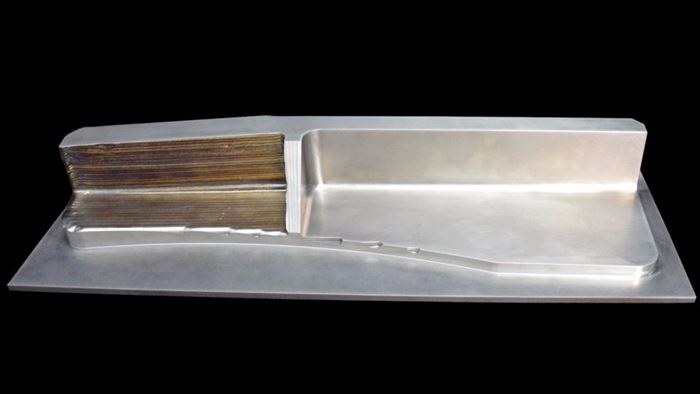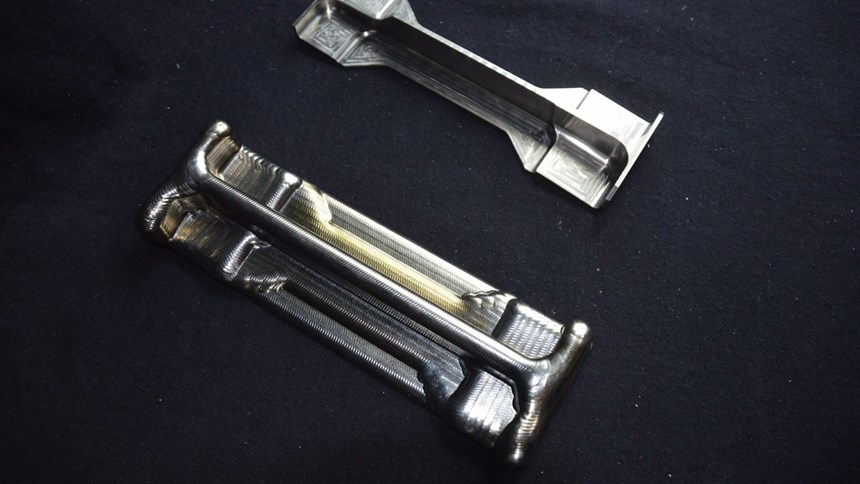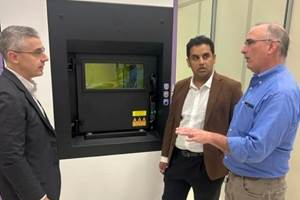Arcing away from Near-Net Forging
An electrical arc process joins a field of additive manufacturing technologies that could one day provide aerospace manufacturers with alternatives to near-net-shape forgings.
Share
Read Next
In the future, pounding heated metal into submission will not be the only viable means of producing certain near-net-shape aerospace components. According to various suppliers, additive manufacturing technology continues to progress toward the same standards for material strength and reliability as forging. They also claim that these freeform deposition processes take less time than forging (a matter of hours for larger components) and bring parts even closer to final geometry. By eliminating the need for tooling and reducing the time and cost required for finish-machining, these forging alternatives promise to compress the front end of the development cycle, reduce the overall production cost of aerospace structural components, and, eventually, facilitate new part designs that would not be feasible with forging.
One of the most recent examples, Rapid Additive Forging (RAF) technology, offers cost savings ranging from 30 to 50 percent on various titanium parts, says Olivier Strebelle, deputy chief executive officer of strategy and business development at Groupe Gorgé, the parent company of RAF technology developer and fellow French firm Prodways. Similar to other metal deposition techniques, the deposition head and the wire material feedstock move together throughout the workzone. Unlike processes that build geometry up from beds of powder, the only restriction on part size is the travel limit of the deposition head, Strebelle says. Although final forms are not as detailed as those produced via powder-bed sintering, they’re more than detailed enough to replace forgings. Metal deposition processes are faster than powder-bed technologies, too.
One of the primary areas in which these freeform material deposition techniques differ is the means of melting the material. RAF uses an electric arc similar to the technology employed by gas-metal-arc welding systems, and testing so far has focused primarily on titanium. The deposition head travels on a robot from Commercy Robotique, another subsidiary of Groupe Gorgé, within an enclosed atmosphere of inert gas. Initial testing shows potential speed advantages compared to laser systems because more power is available, Strebelle says. As for electron-beam sintering systems, “Our assessment is that arc-based technologies are more robust,” he continues. “This is based on our welding experience, where arc-based robots are more reliable.”
However, he emphasizes that the process is still maturing. Engineers are still working toward matching the highest standards of forged-part tensile strength, porosity and other properties. Still, they are getting close. “It could work already for parts that are not of the highest class,” he says, adding that proving the process out for flight-ready parts is likely only a matter of time. In fact, at the time of this writing, Prodways was reportedly working with an aerospace client to qualify parts that could be flying by 2019. New materials, such as aluminum and Inconel, will also undergo further testing. The company is also considering how a RAF system for production might look different than one for prototyping, and how the process might be better integrated with machining, possibly via a hybrid additive/subtractive machine. Size capabilities will most certainly expand, he says, with the next generation systems’ increasing the limit from 70-cm to 3-meter parts.
All of this work is being conducted in Europe, but Strebelle says the company could easily supply blanks produced via RAF technology from its North American headquarters in Minneapolis, Minnesota. As the process matures, he says the technology will likely follow the same path as the company’s other, mostly plastics-focused additive manufacturing offerings, with Prodways eventually moving to offer the RAF systems themselves in addition to RAF production services.
Related Content
8 Cool Parts From Formnext 2024: The Cool Parts Show #78
End-use parts found at Formnext this year address various aspects of additive's advance, notably AM winning on cost against established processes.
Read MoreHow Norsk Titanium Is Scaling Up AM Production — and Employment — in New York State
New opportunities for part production via the company’s forging-like additive process are coming from the aerospace industry as well as a different sector, the semiconductor industry.
Read MoreVideo: For 3D Printed Aircraft Structure, Machining Aids Fatigue Strength
Machining is a valuable complement to directed energy deposition, says Big Metal Additive. Topology-optimized aircraft parts illustrate the improvement in part performance from machining as the part is being built.
Read MoreNew Zeda Additive Manufacturing Factory in Ohio Will Serve Medical, Military and Aerospace Production
Site providing laser powder bed fusion as well as machining and other postprocessing will open in late 2023, and will employ over 100. Chief technology officer Greg Morris sees economic and personnel advantages of serving different markets from a single AM facility.
Read MoreRead Next
Bike Manufacturer Uses Additive Manufacturing to Create Lighter, More Complex, Customized Parts
Titanium bike frame manufacturer Hanglun Technology mixes precision casting with 3D printing to create bikes that offer increased speed and reduced turbulence during long-distance rides, offering a smoother, faster and more efficient cycling experience.
Read MoreProfilometry-Based Indentation Plastometry (PIP) as an Alternative to Standard Tensile Testing
UK-based Plastometrex offers a benchtop testing device utilizing PIP to quickly and easily analyze the yield strength, tensile strength and uniform elongation of samples and even printed parts. The solution is particularly useful for additive manufacturing.
Read MorePostprocessing Steps and Costs for Metal 3D Printing
When your metal part is done 3D printing, you just pull it out of the machine and start using it, right? Not exactly.
Read More






















